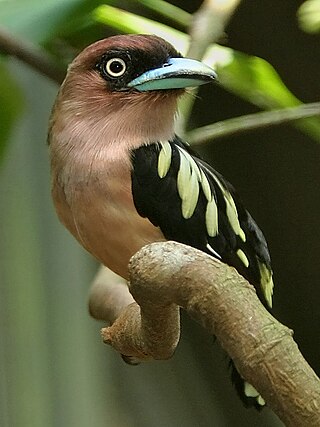
Robert Swinhoe FRS was an English diplomat and naturalist who worked as a Consul in Taiwan. He catalogued many Southeast Asian birds, and several, such as Swinhoe's pheasant, are named after him.

Joseph Beal Steere was an American ornithologist.

The Bugun liocichla is a passerine bird species from the family Leiothrichidae closely related to the Emei Shan liocichla. First spotted in 1995 in Arunachal Pradesh, India, it was described as a new species in 2006. The description was made without the collection of a type specimen as they were too few to risk killing one. It is thought to be an endangered species, with a small population, and a very restricted distribution range within which commercial development threatens the habitat.

The liocichlas are a group of birds in the genus of the same name, Liocichla, from the family Leiothrichidae. They are found in Asia from India to China. They belong to a clade also containing at least the Leiothrix, the barwings, the minlas and the sibias. Among these, they are an early offshoot, or basal lineage.
The Emei Shan liocichla, also known as the Omei Shan or grey-faced liocichla, is a passerine bird in the family Leiothrichidae. It is closely related to the Bugun liocichla, a species only described in 2006, and which it closely resembles.
The black-hooded coucal is a species of cuckoo in the family Cuculidae. It is endemic to Mindoro in the Philippines and is one of the most endangered birds in the country. It is threatened by habitat loss and trapping.

The large hawk-cuckoo is a species of cuckoo in the family Cuculidae. It has a wide breeding distribution from temperate Asia along the Himalayas extending to East Asia. Many populations winter further south. They are known for their loud and repetitive calls which are similar to that of the common hawk-cuckoo but do not rise in crescendo. They are also somewhat larger and adults can be readily told apart from the smaller common hawk-cuckoo by the black patch on the chin. They are brood-parasites of babblers and laughing-thrushes.

Eurylaimus is a genus of broadbills found in Southeast Asia.

The Visayan broadbill is a species of bird in the family Eurylaimidae where it was previously conspecific with the wattled broadbill. It is endemic to the islands of Samar, Leyte and Bohol in the central Philippines. Its natural habitat is tropical moist lowland forests. It is threatened by habitat loss.

The wattled broadbill or Mindanao broadbill is a species of bird in the family Eurylaimidae where it was previously conspecific to the Visayan broadbill. It It is endemic to the islands of Mindanao, Basilan, Dinagat and Siargao in the Philippines. It is one of the most striking birds in the country with its sky-blue wattle and bill and yellow wing patch. Its natural habitats are tropical moist lowland forest, tropical mangrove forest, and tropical moist shrubland. It is threatened by habitat loss.

The red-faced liocichla is a species of bird in the family Leiothrichidae.

The Philippine oriole or grey-throated oriole is a species of bird in the family Oriolidae. It is endemic to the Philippines.

The azure-breasted pitta is a species of bird in the family Pittidae. It is a striking and colorful bird having colors of red, azure, green, black and white, It is endemic to the islands of Mindanao, Bohol, Leyte and Samar in the Philippines. Its natural habitat is tropical moist lowland forest. It is threatened by habitat loss.

The versicolored barbet is a very colorful species of bird in the family Capitonidae, the New World barbets. It is found in Bolivia and Peru.

The Southern Palawan tree squirrel is a species of rodent in the family Sciuridae. It is endemic to the Philippines. Its natural habitat is subtropical or tropical dry forests.

The scarlet-faced liocichla is a bird in the family Leiothrichidae. The species was recently reclassified as separate from the red-faced liocichla, although some taxonomists consider it to be conspecific. It is found in Myanmar, Thailand, Vietnam, and southern China.

The laughingthrushes are a family, Leiothrichidae, of Old World passerine birds. The family contains 133 species which are divided into 16 genera. They are diverse in size and coloration. These are birds of tropical areas, with the greatest variety in Southeast Asia and the Indian subcontinent. The entire family used to be included in the Old World babbler family Timaliidae.















